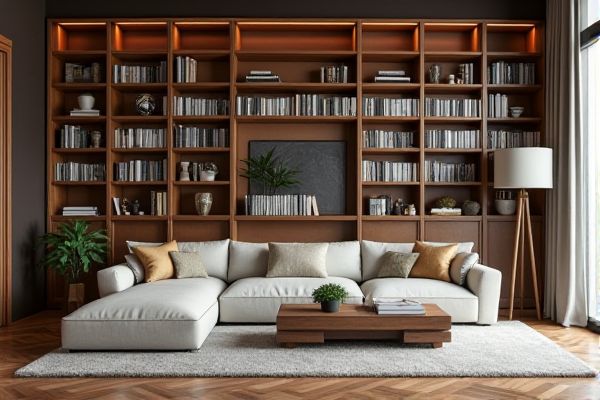
Bookshelves are typically open, wall-mounted units designed to hold a modest number of books, while bookcases are freestanding, larger furniture pieces with multiple shelves that can store a wider variety of items including decorative objects. Discover how choosing the right option can enhance your space and meet your storage needs by reading the full article.
Table of Comparison
| Feature | Bookshelf | Bookcase |
|---|---|---|
| Definition | A flat horizontal surface or set of shelves for storing books. | A larger piece of furniture with multiple shelves, often enclosed, for storing books. |
| Design | Simple, often wall-mounted or standalone shelves. | Freestanding, often enclosed with doors or cabinets. |
| Size | Usually smaller and compact. | Larger and bulkier furniture piece. |
| Capacity | Holds fewer books or decorative items. | Holds a large collection of books and items. |
| Usage | Ideal for minimal spaces and display purposes. | Suitable for extensive book storage and home libraries. |
| Materials | Wood, metal, plastic, or glass. | Primarily wood, often high-quality or antique finishes. |
Introduction: Bookshelf vs Bookcase
A bookshelf typically refers to a single shelf or a set of open shelves designed to hold books, offering easy access and a lightweight structure. A bookcase is usually a larger, enclosed piece of furniture with multiple shelves and often features doors or decorative elements, providing more storage and protection for your collection. Understanding these differences helps you choose the right option for organizing your books based on space and functionality.
Defining Bookshelf and Bookcase
A bookshelf is a single unit or shelf designed to hold books, often open and mounted on a wall or placed on a desk. A bookcase is a larger, freestanding piece of furniture with multiple shelves, typically enclosed with doors or made of wood, designed to store and display a significant number of books. Both serve the purpose of organizing books but differ in size, structure, and placement options.
Design Differences: Bookshelf vs Bookcase
Bookshelves typically feature open shelving with minimal framing, offering a lighter, airier design ideal for displaying books and decorative items openly. Bookcases often have enclosed structures with doors, back panels, and sometimes drawers, providing a more substantial and protective storage solution. The design differences influence both the aesthetic and functional use, with bookshelves favoring openness and bookcases emphasizing containment and organization.
Material Choices for Shelving
Bookshelves typically feature lightweight materials such as metal or plastic, offering portability and modern aesthetics, while bookcases often use solid wood or engineered wood for durability and classic appeal. Wood varieties like oak, pine, and walnut provide sturdy support and timeless style for bookcases, whereas metal bookshelves prioritize industrial design and strength. Material choice impacts the shelf's weight capacity, longevity, and visual integration with room decor.
Storage Capacity Comparison
Bookshelves typically feature open, horizontal shelves designed for displaying a moderate number of books and decorative items, offering flexible but limited storage capacity. Bookcases often have enclosed or more robust shelving units with adjustable shelves, maximizing storage space for larger collections and heavy volumes. The design of bookcases generally supports higher weight capacity and improved organization compared to standard bookshelves.
Aesthetic Impact in Interior Design
Bookshelves offer a minimalist aesthetic with open shelving that showcases books and decor, enhancing light and airiness in your space. Bookcases, often larger and enclosed, provide a more substantial visual anchor that can complement traditional or formal interiors. Your choice influences the room's ambiance by balancing openness versus solidity in interior design.
Functionality and Practicality
Bookshelves offer open storage ideal for frequent book access and display, enhancing room aesthetics with visible organization. Bookcases provide enclosed or semi-enclosed compartments, protecting books from dust while maximizing storage variety through adjustable shelves and additional drawers. Both prioritize functionality, but bookshelves favor easy reach and visual appeal, whereas bookcases emphasize protection and versatile storage options.
Space-Saving Solutions
Bookshelves offer efficient space-saving solutions by providing open, wall-mounted storage that maximizes vertical space without occupying floor area. Bookcases, typically freestanding and larger, deliver more enclosed storage but require a dedicated footprint, which can limit spatial flexibility in smaller rooms. Selecting between a bookshelf or bookcase depends on balancing the need for compactness with the volume of books and decorative items to be stored.
Cost and Value Considerations
Bookshelves typically offer a more budget-friendly option compared to bookcases, making them ideal for those seeking affordable storage solutions. Bookcases, often crafted with sturdier materials and featuring enclosed designs, tend to provide greater durability and aesthetic value, potentially increasing your home's appeal. Evaluating your needs for cost efficiency versus long-term investment will help determine the best choice between the two.
Choosing Between Bookshelf and Bookcase
Choosing between a bookshelf and a bookcase depends on space, design, and functionality needs. Bookshelves are often open and minimalist, ideal for small rooms or decorative displays, while bookcases provide enclosed storage with doors or drawers to protect books from dust. Evaluating available space and preferred aesthetics helps determine whether a sleek bookshelf or a sturdy bookcase better suits organizational and stylistic goals.
 homyna.com
homyna.com